|
|
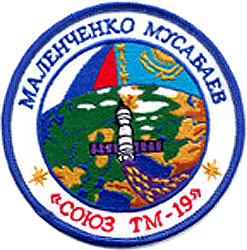
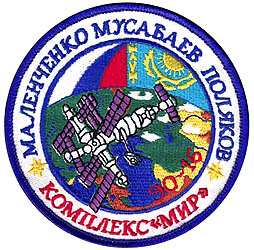
| Design: Konstantin Lantratov | ||
| Manufacturer: APS |
||
| Crew & Mission |

Left: Yuri Malenchenko and Talgat Musabayev in their training Sokols, in their "all Russian" portrait. Right: Talgat Musabayev wearing his TK-4 training flightsuit. The picture was taken after the TM-19 mission - he has replaced the Vimpel patch that was present at his right chest during TM-19 training, with the Kazachstani seal.
The mission of Soyuz TM-19 to the Mir station was planned for May 1994. Originally, the crew would consist of Yuri Malenchenko and Alexandr Kaleri. In May 1993, Kaleri's name was replaced by that of Gennadi Strekalov. It was rumoured that the third seat would be occupied by a journalist. Then, Talgat Musabayev's name was mentioned. Malenchenko and Musabayev would stay behind as Mir's 16th resident crew, while Strekalov would return om Soyuz TM-18 with Viktor Afanasyev and Yuri Usachev.
In February 1994, the launch was planned for June 24, 1994. Already, some sources reported that Strekalov would fly with Dezhurov and an American astronaut on Soyuz TM-21. On April 4, Strekalov was removed from the crew, officially because one of two Progress-M cargo ships that was scheduled to resupply Mir, was cancelled, so that Strekalov�s couch had to carry supplies. The result was an all-rookie flight for TM-19.
In May, the launch was delayed to July 1, 1994, because of problems with the fairing of the Soyuz. The mission was indeed launched on July 1, 1994. Docking occurred without incident on July 3.
On August 16, 1994, it became known that only 2 spacewalks would be made by the crew instead of four. These EVA-s were carried out on 8 and
12 september, 1994. The purpose was the transfer of solarpanels from Kristall to Kvant-1. Also, the cosmonauts did some preparatory work aimed at the future transfer of the solar batteries from Kristall to Kvant. This transfer had been planned for this mission (as depicted in the EO-16 patch!) but was put back to the beginning of 1995.
On November 3, Musabayev, Malenchenko, and Merbold undocked in Soyuz-TM 19 and backed 190 m from Mir. They then activated the Kurs automatic approach system, which successfully redocked the spacecraft. The cosmonauts then transferred back to Mir. The test was related to the difficulties Soyuz-TM 20 and Progress-M 24 experienced during their automatic approaches.
Final undocking and reentry the following day occurred without incident.
| The Flight Sokols |
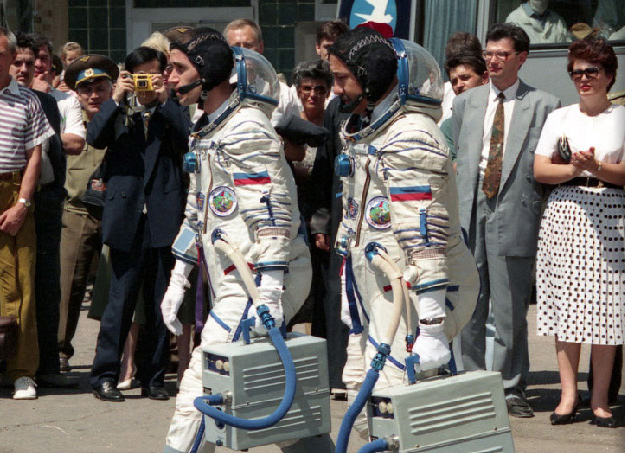
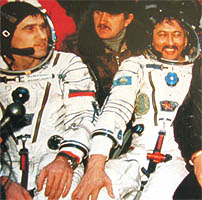
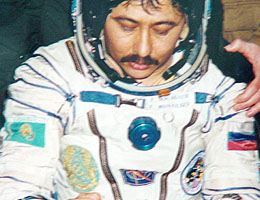
Above: the crew before launch, both wearing the Soyuz TM-19 patch on their Sokols. Left: Malenchenko was not wearing the mission patch during landing. Right: Musabayev was still wearing the patch. He was also wearing a Kazachstani flag patch and a Kazachstani seal on his suit.
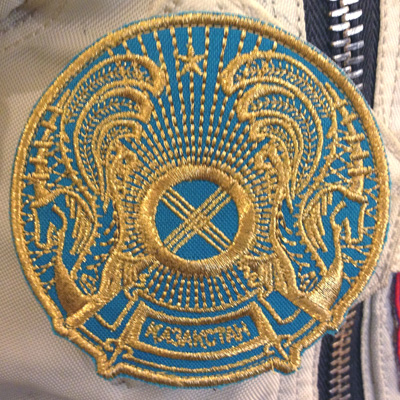
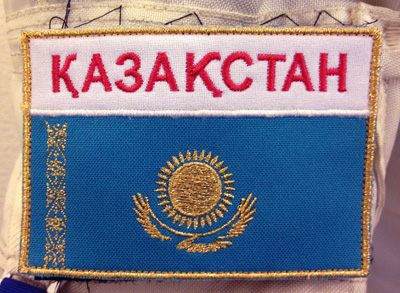
Above: the Kazakh seal and flag on Musabayev's non-flown suit as exhibited today at the Kazkosmos museum in Astana. These are likely not flown patches, as the flag differs from the one seen in the photos above.
| IVA Wear |
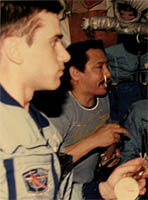
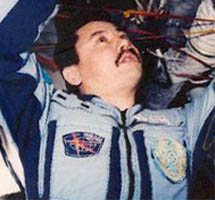
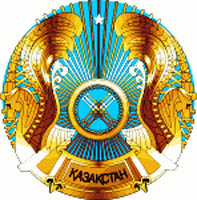
Left: Malenchenko in Penguin-suit. Center: Musabayev wearing his Penguin suit with attached Kazachstani patch. Right: The Kazachstani logo.
| The Orlan EVA-suits |
| Patch History |
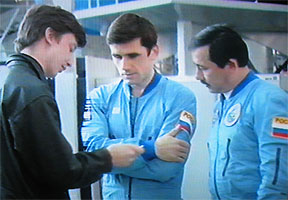
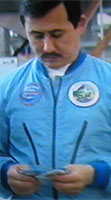
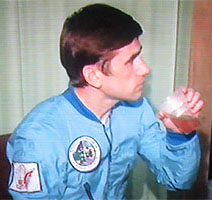
Left: Malenchenko and Musabayev are being presented with their patches by Konstantin Lantratov on June 8, 1994. Musabayev is already wearing the TM-19 patch on his TK-4 training flightsuit. On his right chest, he is wearing the patch of Vimpel, who is the manufacturer of the suit. Center: Musabayev looking at the patches he received. Right: Malenchenko wearing the TM-19 patch.
Following the careful start with the TM-16 an TM-17 patches and the enthusiastic reaction of the TM-18/EO-15 cosmonauts, Novosti Kosmonavtiki was encouraged to take their patch project a step further. Igor Marinin drew up a plan to have RSA approve the patches, so that the crew would be allowed to wear them on their Sokols. When he met with RSA-officials, he was told to reach an agreement with all parties involved. ,,That was easier said than done, because there were no less than 10 organizations. Six cosmonaut groups, Energiya, Zvezda... that's why the patches remained a private initiative", Konstantin Lantratov recalls.
Despite the fact that Marinin was unable to convince RSA, TM-19/EO-16 would bring a change. When spaceflight enthusiasts Jaap "Japio" Terweij and Luc van den Abeelen of Spaceview Operations in Amsterdam, the Netherlands, learned about Novosti Kosmononavtiki's attempts, they offered to have the patches produced by the Dutch firm Aviation Patch Supplies. They believed they could finance the project by selling the patches to the public, like Stewart Aviation had done, but also have some of the profits end up with the designers, something which had apparently bothered Lantratov with Stewart Aviation.
Lantratov and Marinin offered Vadim Molchanov to participate in the project with Spaceview Operations, but he declined. Molchanov, in a letter to Stewart in April 1994: ,,Unfortunately, I have troubled news for you. Some Holland firm offered to the Cosmonauts Training Center to make embroidered patches for all future Russian crews. They are ready to supply crews, as well as the Cosmonaut Training Center, SIA Energiya and the Institute of Medical and Biological Problems [with patches] for gifts and selling. [...] I was invited to this project too. But I replied I never was a traitor and I don't want to do something wrong for my friends from Stewart Aviation."
Molchanov was hopeful nothing would change. ,,I hope very much we will continue to work [together] and we will defeat all your competitors. The command of the Cosmonaut Training Center [did not yet] make their choice - very many officials and cosmonauts wants Stewart Aviation." At Stewart Aviation, a decission had been made, though. Kit from the Design Department: ,,When we heard the badges were made elsewhere, this was when we withdrew from supplying them to Russia." So, the TM-19/EO-16 patches were drawn by Konstantin Lantratov, sent to Jaap Terweij and Luc van den Abeelen and produced by Aviation Patch Supplies. They were presented to the crew in Star City by Lantratov on June 8, 1994.
In the June 4 - July 1, 1994, issue of Novosti Kosmonavtiki, there is a small article about the patches:
,,On June 8th, Konstantin Lantratov engaged in something which has already something of a tradition: before their complex training, he presented the next crew an emblem of their flight. To be honest, this time it was nothing like EO-15. There were a number of problems with the design of the patch - not technical, but because of what should be on it. First of all, it was necessary to develop at once two emblems. Soyuz T-M19 and Mir EO-16 did have different crews: Valery Polyakov would return to the Earth in March, 1995."
,,The color scemes of both patches were approximately identical, there was a difference in the central figure: on the "ship" emblem, there was a flying Soyuz. On the other was the Mir-complex, with the Kristal and Kvant modules and the panel of solar batteries, which would be the most effective experiment on EO-16."
,,Then there was the complexity of the TM-19 crew. In fact, originally Gennady Strekalov would be one of the crew members. However in January, right after the start of EO-15, conversations began about having a two-men crew on the next Soyuz, to have more room for supplies, so that a Progress-flight could be spared. On April 1, the decision was taken. Not only Russia, but also Holland was waiting for this decision, where the firm Aviation Patch Supplies had agreed to make the emblems avialable before the training of the crew. There was not much time, only two months, so on the available sketches of emblem of the ship it was necessary to do a quick correction: remove the name of Strekalov."
,,Then, there were difficulties in the delivery of the emblems. The training had shifted an hour early, so when we arrived at Star City, the crew was already in the simulator, preparing for a simulated launch. Also, it seemed not clear yet if Musabayev would fly. On both emblems, there were flags of Russia and Kazakhstan... To get out of this situation, we explained the presence of the Kazakhstan flag by the joint scientific program of experiments, which were developed in Russia an Kazakhstan. But all has ended well. The crew has received the emblems and they liked them. Yuri Malenchenko also has promised to take a pair of EO-16 emblems in space for Valery Poljakov."
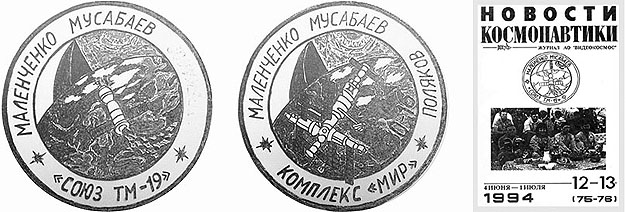
The original Soyuz TM-19 and EO-16 sketches as faxed from Novosti Kosmonavtiki to Spaceview Operations. The EO-16 artwork was first published in the May 7, 1994 issue; a larger picture of the TM-19 patch was presented on the cover of the June 4 - July 1, 1994 issue of Novosti Kosmonavtiki, including a picture of the two cosmonauts wearing the patches. Note that the TM-19 crew originally had three crew members: the missing name is that of Gennadi Strekalov, who was removed from the crew three months before launch.
Although the patches arrived in time to be presented to the crew before the mission, Lantratov was not too happy with the result, he later admitted. ,,When the emblems were embroidered, I concluded that they in general did not succeed. Because of the fine details in the background, they came out very speckled. They looked like eastern carpets." Also, he realized he had made a mistake: ,,On the emblem, Mir was depicted during the most interesting experiment of the mission - the transfer of a solar panel from Kristal to Kvant. But the transfer of the panel was not required during EO-16, it was carried out by the crew of EO-18 - Vladimir Dezhurov and Gennadi Strekalov. The first error on the Russian emblems thus appeared. Since then, my designs no longer included forthcoming operations which could be rescheduled. I tried to make the emblems more symbolic."
There had been no agreement between Novosti Kosmonavtiki and RSA about the patches, but Musabeyev and Malenchenko did wear them on their Sokols during launch. Musabayev was still wearing it when they returned to Earth. Probably Musabayev liked the patch in particular because it included the Kazakhstani flag. After all the discussions whether the flight should be considered Russian or Russian-Kazakhstani, the patches - along with the Kazakhstani flag and seal on his suit - carried a strong message.
Lantratov: ,,Not long before the flight, the emblems were presented to the crew during training. They were very pleased. But with the official photograph of the crew, problems began. If the government of Russia saw the mission as purely Russian, then what was to be done with the Kazakhstani flag on the emblem? The explanation that this flag stood for the Kazakhstani scientific program, proved to be not very convincing. It was necessary for the TSPK photographer to make two versions of the official photograph. On one Yuri and Talgat only wore Russian symbols. On another, they were wearing the emblems, and on Talgats suit even was a Kazakhstani flag. When the cosmonauts cosmonauts arrived at Baikonur, a decission was made. President Yeltsin agreed with president Nazarbayev to consider the expedition Russian-Kazakhstani." (Despite this, the crew portrait with the Kazakhstani patches was not used - the only version known is the Russian one).
| The TSPK patch |
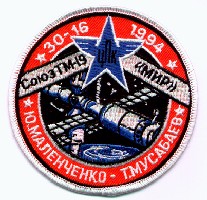
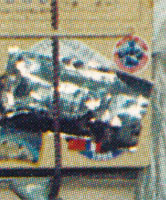
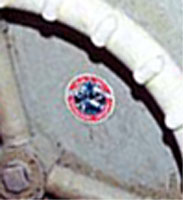
Left: Alternate patch design. Center: The alternate design seen as sticker attached to a panel in the Mir base block. Right: Sticker attached to the EVA hatch.
Although the Novosti Kosmonavtiki/Spaceview Operations EO-16 design was actually worn by Musabayev and Malenchenko on their Sokol suits, they also took stickers with them showing an alternate design. Lantratov: ,,For EO-16, TSPK also released an emblem. On it were the "wings" from the emblem of the Soviet Airforce, and on top the letters TSPK. Most likely, it was drawn by an artist from TSPK." Lacking national symbols, thus evading the Russian-Kazakhstani discussion, the sticker might have been issued by TSPK as a more acceptable alternative for Lantratov's patch.
Lantratov, who mistakenly believes in a January 2000 Novosti Kosmonavtiki article that the patch had been available in embroidered form to the crew, states: ,,But I never saw this patch in any of the photographs of the crew." Actually, the TSPK design was made into an embroidered patch years later by Randy Wagner of Eagle One Aerospace in Virginia, as a souvenir.
| Personal Molchanov patches |
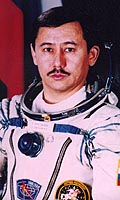
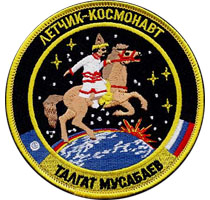
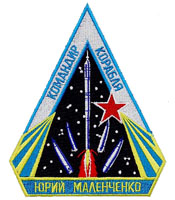
Left: Musabayev wearing his personal Molchanov patch. Center: Musabayev's Molchanov patch. Right: Malenchenko's Molchanov patch
| Collecting Soyuz TM-19/EO-16 |
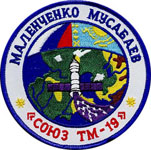
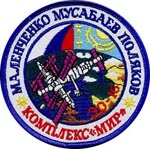
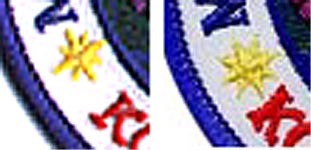
Left: Stewart Aviation TM-19 patch. Left center: Stewart Aviation EO-16 patch. Right Center: Detail of Aviation Patch Suplies patch EO-16. Right: Detail of Stewart Aviation EO-16 patch.
It is very hard to distinguish the original Aviation Patch Suplies EO-16 versions from the Stewart copies, but lettering is finer and there is more space around the the two yellow stars. The Spaceview TM-19 version can easily be recognized: lettering is finer, the Soyuz "exhaust plume" has orange instead of white dots and the landscape is much more detailed.
The Stewart Aviation patches are still available; the Spaceview versions are sold out. The "red" EOA-patch is still available from Randy Hunt in Florida and from Mary Wagner of Cargo Bay Emblems.
A black/purple Kazachstani logo was also produced by Stewart Aviation, as a souvenir. We do not know why they chose these colors.